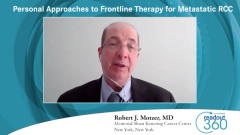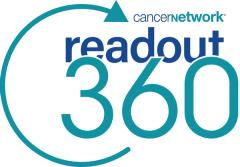
Future Use of Novel Combinations for Metastatic RCC Treatment
Drs Toni Choueiri and Robert J. Motzer highlight various strategies with novel-based therapies being explored to address limitations surrounding the treatment of metastatic renal cell carcinoma.
Episodes in this series

Toni Choueiri, MD: We need to get rid of COVID-19, and we need to get back together. We are embarking, at the Dana-Farber Cancer Institute, on a study of COVID-19 from a clinical perspective, looking into what the risk factors are in patients with cancer who get COVID-19. We integrated that into our research. Once we are done controlling COVID-19 by whatever way you want to, then we can talk more about the future of renal cell carcinoma [RCC]. There are combinations, and there are new targets.
Combination-wise, I am excited about integrating TKIs [tyrosine kinase inhibitors] with NIVO/IPI [nivolumab, ipilimumab], with CTLA-4, PD-1. COSMIC-313 is a study that adds cabozantinib with a modern control, nivolumab and [ipilimumab]; it’s accruing very well. I am one of the leaders of this study. PEDIGREE is another important study that starts with [nivolumab, ipilimumab] and then based on the response, it adds cabozantinib. There are triplets emerging with other combinations as the control arm, where the control arm is not sunitinib single-agent TKI. So the triplets concept is important.
The second is novel targets, and there are many novel targets here and I divide them into immunotherapy and not immunotherapy. The not immunotherapy is the HIF-2 [hypoxia-inducible factor-2] inhibitor, you have seen that at [the Genitourinary Cancers Symposium 2021]. There were 2 oral presentations out of 4 on the HIF-2 inhibitor. That led to an ongoing study, post–PD-1, post-VEGF, with the HIF-2 inhibitor belzutifan. In the initial study with clear cell RCC, the response rate in a highly refractory population was 25%, a first-in-class agent. The HIF-2 target was elusive for a long time, it’s a transcription factor, it does lack those pockets where a small molecule can go in. But people smarter than I am were able through eloquent crystallographic work to find molecules that go there. We use them in first-generation HIF-2 inhibitors, now second generation. We saw with the second generation a response rate of 25%, with a favorable [adverse] effect profile. We see anemia and hypoxia, which are both on target.
We don’t see the bothersome immune-related AEs [adverse effects]. We don’t see the bothersome VEGF-targeted therapy [adverse] effects of fatigue, diarrhea, and hypertension. We combined it with cabozantinib, there were some dose reductions, but we’ve seen activity. HIF-2 [inhibitors] are drugs that work on tumor metabolism, which is a big thing. Unfortunately, we had a setback with a negative study with the glutaminase inhibitor in combination with the VEGF/TKI from Calithera [Biosciences, Inc]. We have to continue here, continue the fight for new targets. Moving to immunotherapy, besides novel immune checkpoints, like TIGIT [T-cell immunoreceptor with immunoglobulin and ITIM domain], and others that are being used, CAR [chimeric antigen receptor] T cells are making an entry into solid tumors, including renal cell. A pegylated form of IL-2 [interleukin-2] showed activity with nivolumab, and showed efficacy.
There is a study by the name PIVOT-09, with nivolumab plus pegylated IL-2, NKTR-214, versus TKI, which is ongoing. We always need a new target. We need this despite, this is a bit naive to say, going for the cure. That’s actually what the patients want at the end of the day. There are other cancers where this [a cure] was possible: testicular cancer, leukemias, and lymphoma. We always have to think about that while we are remaining realistic. Sometimes progress comes in incremental steps.
Adjuvant studies and adjuvant drugs in renal cell cancer remain a bit elusive, unlike bladder [cancer], for example, another tumor where you could discuss chemotherapy. Here you have 1 FDA-approved drug, sunitinib, which is not much use because of the absence of an OS [overall survival] benefit, the decrease in quality of life, and because other trials with VEGF and TKIs did not show the benefit in disease-free survival. We and others have launched studies in the adjuvant high-risk patient with an immune checkpoint inhibitor. Two studies, one was atezolizumab and pembrolizumab, finished accrual, and 2 or maybe 3 others are accruing. Two finished accrual. If these studies are going to show a benefit that we accept, disease-free survival and/or OS, it’s going to make us look again and say how do we apply this frontline trial? This is a patient who was on an adjuvant study with [pembrolizumab], or this is a patient who received adjuvant [pembrolizumab or atezolizumab].
Let’s say the studies are positive for a year and a half and now their tumor progressed, should we give them [nivolumab/ipilimumab], [pembrolizumab/lenalidomide], or the triplet? Most of these studies did not allow adjuvant IO [immunotherapy], what’s the response of IO post-IO? There are studies addressing this, one I’m leading with [Thomas] Powles, [MD,] with cabozantinib/atezolizumab versus cabozantinib only. That also might take the field by storm, just because we’re not ready. We didn’t have the particular setting, it’s going to create confusion in the first line, and we need to accumulate data.
Robert J. Motzer, MD: In first-line therapy, the priority trial that I see that’s being conducted right now is the COSMIC-313 trial. That is a randomized trial that looks at [ipilimumab/nivolumab] plus cabozantinib versus [ipilimumab/nivolumab] plus placebo. It’s a trial that’s looking at whether there’s a benefit for combining an IO combination with a very potent TKI, cabozantinib, in a first-line therapy for RCC. To date, the studies that have shown that IO/TKI combinations are very effective, and [ipilimumab/nivolumab] as an IO/IO combination is very effective. That is going one step further to look to see whether the triplet adds benefit and is a tolerable regimen, and I see it as the priority phase 3 trial to watch that will hopefully gain us a step further in terms of efficacy and benefit to our patients.
Transcript edited for clarity.
Newsletter
Stay up to date on recent advances in the multidisciplinary approach to cancer.



































































































